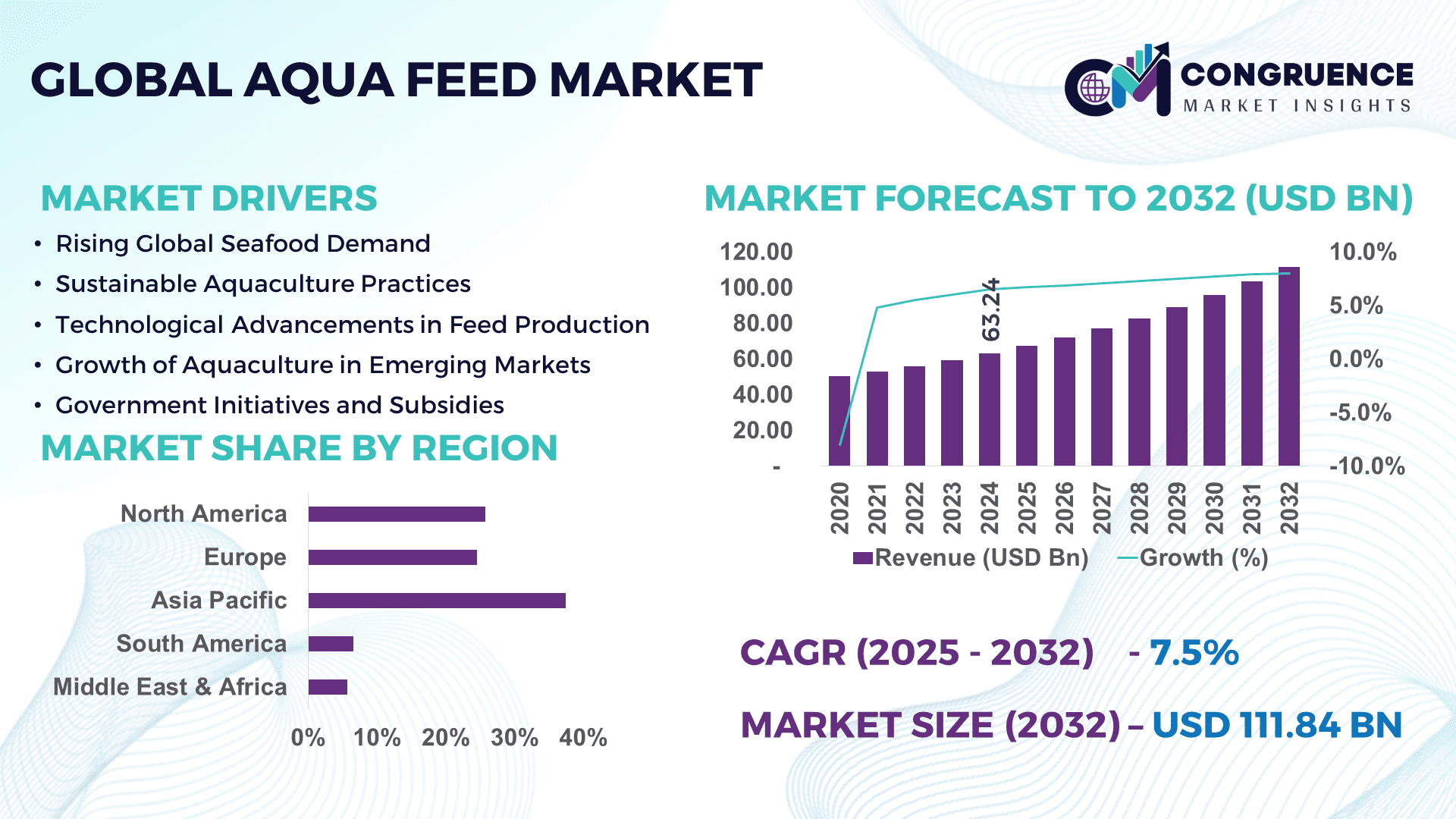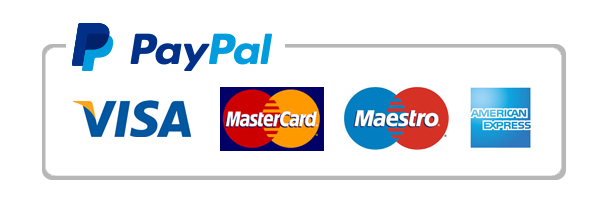Reports
Aqua Feed Market Report Overview
The Global Aqua Feed Market was valued at USD 63.24 Billion in 2024 and is anticipated to reach a value of USD 111.84 Billion by 2032 expanding at a CAGR of 7.5% between 2025 and 2032. The industry is being pushed by increased global demand for seafood, innovations in aquaculture techniques, and the increasing use of nutritionally balanced feed to improve aquatic species' growth and health.

To Learn More About This Report, Request A Free Sample Copy
The aqua feed business is critical to modern aquaculture, supplying nutritionally balanced feed to improve the growth, immunity, and productivity of numerous aquatic species. The growing worldwide population and increasing demand for protein-rich seafood have resulted in a rapid development of aquaculture production, pushing up demand for high-quality aqua feed. Concerns about overfishing and environmental sustainability are driving an increase in demand for sustainable, high-protein feed alternatives such as plant-based proteins, insect meal, and microbial protein. Furthermore, the incorporation of AI-powered monitoring systems in aquaculture is improving feed efficiency and production outcomes, making precision feeding a hot topic in the industry.
Sustainability is a primary priority, with producers investing in alternative protein sources such as algae-based feed, plant proteins, and insect-derived feed ingredients to minimize dependency on fishmeal and fish oil. The business is also seeing technology developments, including as automated feeding systems, real-time health monitoring, and AI-powered feed optimization tools, which help to reduce feed waste and maximize fish growth efficiency.
Furthermore, strict government rules on feed safety and sustainability are influencing the market, pushing advances in additives, probiotics, and enzymes to increase digestibility and reduce the environmental impact of aquaculture waste. The future of the aqua feed market is in sustainable, cost-effective, and precision-based solutions that satisfy the changing needs of aquaculture producers throughout the world.
How AI is Transforming Aqua Feed Market
Artificial intelligence (AI) is transforming the aqua feed industry by improving feeding tactics, increasing sustainability, and lowering production costs. AI-driven precision feeding systems use real-time data from aquaculture environments, such as water quality, fish activity, and growth rates, to autonomously modify feeding schedules and volumes. This method reduces feed waste, increases nutritional efficiency, and improves the general health of aquatic organisms.
AI-powered computer vision and machine learning algorithms can identify feeding habits and fish density, allowing farmers to improve feed distribution. This decreases overfeeding, a major cause of water pollution and feed inefficiency in aquaculture. Furthermore, AI-powered data enable predictive maintenance of feeding systems, ensuring uninterrupted operations with minimal disruption.
Furthermore, artificial intelligence is enhancing feed formulation processes by examining nutritional requirements, species-specific demands, and cost-effective ingredient alternatives. With growing worries about sustainability, AI is being used to create alternative feed compositions that include insect proteins, algae-based components, and fermented feed solutions, reducing reliance on fishmeal. As AI use grows, the aqua feed sector will see increased efficiency, lower prices, and more sustainable aquaculture feed production.
Aqua Feed Market Major Driving Forces
· Increasing Global Seafood Demand: Rising per capita seafood consumption and increased knowledge of health benefits are boosting demand for healthy aqua feed to boost aquaculture production.
· Sustainable Aquaculture Practices: Regulatory challenges and environmental concerns are driving a change toward eco-friendly and plant-based feed alternative, lowering reliance on marine-derived nutrients.
· Technological Advancements: Technological advancementsin feed production include advances in extrusion technology, probiotics, and enzymes that improve feed digestibility, nutritional value, and waste reduction.
· Aquaculture Growth in Emerging Markets: As Asia Pacific and Latin America grow aquaculture output, demand for commercially manufactured feed to sustain large-scale fish farming rises.
· Government Initiatives and Subsidies: Policies that promote sustainable fisheries and aquaculture growth encourage investments in high-quality feed solutions to increase yield efficiency in the aqua feed industry.
Aqua Feed Market Key Opportunities
· Expansion of Alternative Protein Sources: Increased investment in insect meal, algae-based feeds, and microbial proteins will provide major growth potential in the aqua feed business.
· Growth of Precision Aquaculture: Precision aquaculture is on the rise, thanks to AI-powered automated feeding systems and real-time monitoring technologies that allow for better feed use and higher profits for aquaculture operators.
· Rising Demand for Functional Feed Additives: The increased use of probiotics, prebiotics, and omega-3-rich feed formulations improves fish immunity and disease resistance.
· Sustainability and Circular Economy Initiatives: As the industry transitions to zero-waste aquaculture, there is a growing demand for feed innovations that incorporate agricultural byproducts and fermented feed solutions.
Aqua Feed Market Key Trends
· For more sustainable formulations, companies are using less fishmeal and more soy protein, canola meal, and algae-based components.
· The use of IoT and AI-powered feeding technology enables automatic, real-time feed modifications depending on fish behavior.
· Digestive enzymes, probiotics, and organic acids are increasingly used to increase feed conversion ratios and reduce waste output.
· The use of food waste and agricultural wastes to produce nutrient-dense, environmentally friendly feed is gaining traction.
Region-wise Market Insights
Asia Pacific accounted for the largest market share at 37.4% in 2024 moreover, Asia Pacific is expected to register the fastest growth, expanding at a CAGR of 8.2% between 2025 and 2032.

To Learn More About This Report, Request A Free Sample Copy
Asia Pacific dominates the market with a 37.4% share, valued at USD 23.65 billion in 2024, and is the fastest-growing region, with a CAGR of 8.2%. This dominance is fueled by high seafood consumption, government backing for aquaculture expansion, and increased investment in feed innovation. Countries such as China, India, Vietnam, and Indonesia are major manufacturing hubs.
· In March 2025, BioMar has acquired full ownership of a Norwegian aquaculture research center, strengthening its R&D capabilities in sustainable fish and shrimp feed. This acquisition will enhance BioMar’s ability to develop and test innovative aquafeed solutions, supporting the industry’s evolving needs. The move aligns with BioMar’s strategy to advance sustainable aquaculture through scientific research and innovation.
North America is seeing an increase in demand for sustainable aquafeed, with investments in alternative protein sources such as insect and microbial feeds.
Europe is concentrating on environmentally friendly, non-GMO feeds, with strict feed safety rules encouraging sustainability projects.
South America, the Middle East, and Africa are expanding markets with growing aquaculture activity, particularly in Brazil, Chile, Egypt, and Saudi Arabia.
Recent Developments
· In January 2025, Cargill invested $10 million to establish its first fish feed plant in India. The facility aims to enhance local aquaculture production by providing high-quality, sustainable feed solutions. This investment supports India's growing demand for efficient fish farming and aligns with Cargill’s commitment to advancing global aquaculture.
· In October 2024, Cargill updated its shrimp feed portfolio with a focus on high-performance nutrition. The new approach optimizes growth efficiency, sustainability, and resilience in shrimp farming. By integrating advanced feed technology, Cargill aims to enhance production outcomes while reducing environmental impact.
· In October 2024, Skretting is set to invest $15 million in expanding its aquafeed facility in Japan. The investment will enhance production capabilities and meet growing demand for high-quality aquafeed in the region. The company aims to support sustainable aquaculture growth by leveraging advanced feed technology and expertise. This expansion aligns with Skretting’s broader strategy of strengthening its presence in key aquaculture markets worldwide.
· In September 2024, Skretting partnered with Zooca to introduce a copepod-based feed for marine juvenile fish. This innovative feed aims to enhance early-stage fish nutrition, improving survival rates and growth performance. Copepods are a natural and highly nutritious food source, making them an ideal component for hatchery diets. This development aligns with the aquaculture industry's focus on sustainability and optimized fish health.
Market Competition Landscape
The global aqua feed market is very competitive, with key competitors working on innovation, sustainability, and regional expansion to bolster their market positions. Companies are investing in alternative protein sources such as insect meal, algae-based feeds, and fermented proteins to minimize their reliance on fishmeal and improve environmental sustainability.
Leading companies such as Cargill, Skretting (Nutreco), and BioMar are expanding their production capacity and introducing functional feed solutions enhanced with probiotics, prebiotics, and omega-3 supplements to boost aquatic species' health and growth rates. Furthermore, the integration of AI-powered precision feeding technology is becoming a competitive advantage, allowing businesses to enhance feed efficiency and reduce waste.
Strategic collaborations, acquisitions, and R&D investments are all effective growth methods. Regional players, particularly in Asia Pacific and South America, are expanding their footprint by meeting local aquaculture demands. As sustainability and efficiency become more important, organizations who invest in environmentally friendly, high-performance feed solutions will keep a competitive advantage in the marketplace.
Key players in the global aqua feed market implement various organic and inorganic strategies to strengthen and improve their market positioning. Prominent players in the market include:
· Cargill, Inc.
· Skretting (Nutreco)
· BioMar Group
· Ridley Corporation
· Charoen Pokphand Foods PCL
· Archer Daniels Midland (ADM)
· Aller Aqua Group
· Purina Animal Nutrition
· Guangdong Haid Group
· De Heus Animal Nutrition
· Zeigler Bros., Inc.
· Nutriad (Adisseo)
· Dibaq Aquaculture
· Avanti Feeds
|
Report Attribute/Metric |
Details |
|
Market Revenue in 2024 |
USD 63.24 Billion |
|
Market Revenue in 2032 |
USD 111.84 Billion |
|
CAGR (2025 – 2032) |
7.5% |
|
Base Year |
2024 |
|
Forecast Period |
2025 – 2032 |
|
Historical Data |
2020 to 2024 |
|
Forecast Unit |
Value (US$ Bn) |
|
Key Report Deliverable |
Revenue Forecast, Growth Trends, Market Dynamics, Segmental Overview, Regional and Country-wise Analysis, Competition Landscape |
|
Segments Covered |
· By Type (Pellets, Extruded, Mash, and Others) · By Ingredient (Soybean, Corn, Fishmeal, Additives, and Others) · By Species (Fish, Crustaceans, Mollusks, and Others) · By End-Use (Aquaculture Farms, Hatcheries, and Others) |
|
Geographies Covered |
North America: U.S., Canada and Mexico Europe: Germany, France, U.K., Italy, Spain, and Rest of Europe Asia Pacific: China, India, Japan, South Korea, Southeast Asia, and Rest of Asia Pacific South America: Brazil, Argentina, and Rest of Latin America Middle East & Africa: GCC Countries, South Africa, and Rest of Middle East & Africa |
|
Key Players Analyzed |
Cargill, Inc., Skretting (Nutreco), BioMar Group, Ridley Corporation, Charoen Pokphand Foods PCL, Archer Daniels Midland (ADM), Aller Aqua Group, Purina Animal Nutrition, Guangdong Haid Group, De Heus Animal Nutrition, Zeigler Bros., Inc., Nutriad (Adisseo), Dibaq Aquaculture, Avanti Feeds |
|
Customization & Pricing |
Available on Request (10% Customization is Free) |
